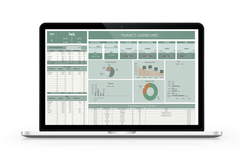Goal: one simple routine on payday that keeps the lights on, grows your buffer, and still leaves room for joy.
Why it works: decisions happen once (when you set it up), not every time you get paid.
- Bills first (rent/mortgage, council tax, utilities, debt minimums).
- Buffer next (£500–£1,000 starter; then 3 months).
- Pots for near-term stuff (car, house, annual subs, travel).
- Fun with what’s truly left.
Automate all four for the day after payday.

1) Bills (non-negotiables)
- List fixed bills + minimum debt payments.
- Change due dates to payday +2 where possible to avoid overdraft traps.
- One Bills account/pot is cleaner than ten different due dates.
Numbers example (net pay £2,200):
Rent 950 • Council tax 150 • Energy 120 • Water 35 • Broadband 28 • Mobile 15 • Transport 150 • Debt mins 120 → Bills total: £1,568
Automate: standing order to Bills account: £1,568 on payday +1
RELATED: Want to Get Out of Debt FAST? Get Real and Take Action!
2) Buffer (peace first)
- Target £500–£1,000 quickly; then climb toward 3 months’ essentials.
- Easy-access account (FSCS protected); don’t rate-chase until you hit £1k.
Example: set standing order £200 to “Emergency/Buffer” on payday +1.
Micro-habit: if tight, start £10/week. Momentum > perfection.
3) Pots (stop surprise bills)
Think next 3–12 months. Add rough annual totals ÷ 12.
- Car (MOT/tyres/insurance): £600/yr → £50/mo
- Gifts/Christmas: £480/yr → £40/mo
- Annual subs (Amazon, antivirus, pro tools): £240/yr → £20/mo
- Medical/dental/eyes: £180/yr → £15/mo
- Home maintenance: £300/yr → £25/mo
Example: If your pots total £150/mo, set a single standing order to your Sinking Funds pot on payday +1, then split it inside (Car, Gifts, Subs, Medical, etc.).
Sinking funds
What : small, earmarked pots for costs you know are coming in the next 3–12 months.
Why: stops “surprise” bills nuking your buffer or going on credit.
How much: annual cost ÷ 12 → automate monthly on payday +1.
Typical pots (pick 3–6): Car (MOT/tyres/insurance), Gifts/Christmas, Annual subs, Medical/dental/eyes, Home repairs, Travel, Kids, Pets.
Spend rules: keep in easy-access Pots/Spaces (FSCS), spend only from the matching pot, top up next payday. Avoid PBs/fixed terms here—access matters.
4) Fun (guilt-free)
What’s left after 1–3 is yours. Spend it without second-guessing.
- Eating out, hobbies, small luxuries.
- If Fun feels too small → you need to trim Bills or Pots, not steal from Buffer.
What the payday split looks like (worked examples)
| Net Pay | Bills | Buffer | Pots | Fun (leftover) |
|---|---|---|---|---|
| £1,600 | £1,150 | £100 | £120 | £230 |
| £2,200 | £1,568 | £200 | £150 | £282 |
| £3,000 | £1,900 | £400 | £250 | £450 |
Adjust Buffer/Pots up or down based on your goals; Bills are fixed, Fun flexes.
How to automate in 15 minutes
- Pick one “hub” account for income.
- Create pots/spaces: Bills, Buffer, Sinking Funds, Fun.
- Set standing orders for payday +1:
- to Bills = total of fixed bills,
- to Buffer = your monthly target,
- to Sinking Funds = your pots total.
- Set direct debits from the Bills pot only.
- Optional: round-ups ON; sweep any month-end Fun leftovers → Buffer.
(Banks differ, but these exist on most UK accounts: Monzo “Pots”, Starling “Spaces”, Chase “Round-ups”, legacy banks offer “Savings goals” or separate savers.)
RELATED:
Order of operations (when you have debt/savings goals)
- All minimums on every debt.
- Starter Buffer £500–£1,000.
- If high-interest debt (APR > savings rate): funnel extra to debt (Snowball for motivation / Avalanche for interest saved).
- When consumer debt gone: grow buffer → invest (ISA/SIPP), then optimise accounts.
Troubleshooting (quick fixes)
-
“I keep raiding my buffer.”
Move it to a separate bank + 24h transfer delay. Label the pot “Emergency only.” -
“Annual subs still ambush me.”
Add a calendar alert 28 days before renewal; review if you still want it. -
“Food blows the Fun category.”
Try a weekly grocery pot (not monthly) and shop the same day each week. -
“Irregular income?”
Pay yourself a fixed baseline “salary” into the hub account monthly; keep the rest in an Income Buffer to smooth lean months.
Tiny scripts that save money
-
Broadband retention:
“I’m out of contract and comparing deals. What’s the best price you can do to keep me?” -
Insurance timing:
Renew 28–20 days before expiry; quotes are often cheaper than last-minute.
Tools that make this easier
-
Free Savings Distribution Tracker (Google Sheets): paste your pay; it splits Buffer / Pots / Goals and charts it.
-
Debt Snowball/Avalanche Calculator: see fastest vs cheapest route.
-
Free Quick Budget Calculator: full monthly view.
FAQs
Isn’t it better to invest first?
Not until you have a starter buffer and no high-interest consumer debt. Avoid selling investments to cover a boiler repair.
Where should the buffer live?
Easy-access savings with FSCS protection. Optimise rates after you hit £1k.
What about Premium Bonds?
They’re fine for some as a side pot; returns aren’t guaranteed. Keep the starter buffer in cash.





